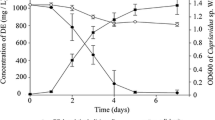Abstract
Pseudomonas fluorescens IP01 grown on isopropylbenzene (cumene) and Acinetobacter sp. 20B grown on dimethyl sulfide (DMS) degraded up to 90% and 25% of 1.5 mg trichloroethylene (TCE)/l, respectively. Escherichia coli harboring the DMS monooxygenase genes from strain 20B, the cumene dioxygenase genes from strain IP01 and both oxygenase genes, degraded up to 50%, 75% and 88% of 75 mg TCE/l, respectively. The growth rates of the E. coli recombinants remained nearly unaffected by TCE at 15 150 mg/l. Thus, the E. coli recombinants were indicated to degrade high concentrations of TCE efficiently at least up to 150 mg l−1.
Similar content being viewed by others
References
Adam W, Bialas J, Hadjiarapoglou L (1991) Chem. Ber. 124: 2377.
Alvarez-Cohen L, McCarty PL (1991) Appl. Environ. Microbiol. 57: 228–235.
Aoki H, Kimura T, Habe H, Yamane H, Kodama T, Omori T (1996) J. Ferment. Bioeng. 81: 187–196.
Ayobi PK, Harker AR (1998) Appl. Environ. Microbiol. 64: 4353–4356.
Bovicelli P, Lupatterlli P, Mincione E (1992) J. Org. Chem. 57: 2182–2184.
Fitch MW, Speitel GE Jr, Georgiou G (1996) Appl. Environ. Microbiol. 62: 1124–1128.
Freitas dos Santos LM, Livingston AG (1995) Biotechnol. Bioeng. 47: 82–89.
Furukawa K, Hirose J, Hayashida S, Nakamura K (1994) J. Bacteriol. 176: 2121–2123.
Heald S, Jenkins RO (1994) Appl. Environ. Microbiol. 60: 4634–4637.
Horinouchi M, Kasuga K, Nojiri H, Yamane H, Omori T (1997) FEMS Microbiol. Lett. 155: 99–105.
Jahng D, Wood TK (1994) Appl. Environ. Microbiol. 60: 2473–2482.
Little CD, Palumbo AV, Herbes SE, Lidstrom ME, Tyndall RL, Gilmer PJ (1988) Appl. Environ. Microbiol. 54: 951–956.
Nakajima T, Uchiyama H, Yagi O, Nakahara T (1992) Biosci. Biotech. Biochem. 56, 486–489.
Nelson MJK, Montgomery SO, Mahaffey WR, Pritchard PH (1987) Appl. Environ. Microbiol. 53: 949–954.
Newman LM, Wackett LP (1991) Appl. Environ. Microbiol. 57: 2399–2402.
Oldenhuis R, Oedzes JY, van der Waarde JJ, Janssen DB (1991) Appl. Environ. Microbiol. 57: 7–14.
Sambrook J, Fritsch EF, Maniatis T (1989) Molecular Cloning, 2nd ed., A Laboratory Manual. Cold Spring Harbor, NY: Cold Spring Harbor Laboratory Press.
Speitel GE Jr, Thompson RC, Weissman D (1993) Water Res. 27: 15–24.
Tsien HC, Brusseau GA, Hanson RS, Wackett LP (1989) Appl. Environ. Microbiol. 55: 3155–3161.
Wackett LP, Gibson DT (1988) Appl. Environ. Microbiol. 54: 1703–1708.
Wackett LP, Householder SR (1989) Appl. Environ. Microbiol. 55, 2723–2725.
Yanish-Perron C, Vieira J, Messing J (1985) Gene 33: 103–119.
Author information
Authors and Affiliations
Rights and permissions
About this article
Cite this article
Takami, W., Horinouchi, M., Nojiri, H. et al. Evaluation of trichloroethylene degradation by E. coli transformed with dimethyl sulfide monooxygenase genes and/or cumene dioxygenase genes. Biotechnology Letters 21, 259–264 (1999). https://doi.org/10.1023/A:1005404931086
Issue Date:
DOI: https://doi.org/10.1023/A:1005404931086




